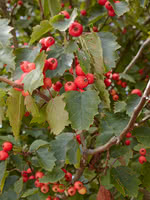Mon-Fri 9am - 5pm Mountain time
Arnold Hawthorn vs Andrew Hazelnut
Crataegus arnoldiana
Corylus heterophylla Het 1
NOT AVAILABLE THIS SEASON - MIGHT RETURN
NOT AVAILABLE THIS SEASON - MIGHT RETURN
Arnold Hawthorn is a low-branched tree favored by wildlife and landscapers. This tree's beautiful white flowers and bright red berries make it an attractive ornamental in anyone's yard. Arnold Hawthorn is also used in windbreaks and riparian planting.
Despite its thorns, Arnold Hawthorn is a popular choice of food and shelter for deer and birds. Humans can also eat these berries fresh or preserved, but Arnold Hawthorn will not have high yields until it matures at 5-8 years.
Andrew Hazelnut is a northern cultivar that is grown specifically for its cold hardiness. Typically, hazelnuts produce smaller nuts in colder climates, but for Andrew Hazelnut, this is not the case.
This hybrid variety is incredibly productive, growing medium sized nuts that ripen in late August. Pair with another Andrew or Aldara Hazelnut for cross pollination to occur.
The edible nuts can be eaten fresh, used in baking, and will make a beautiful hedge. Andrew Hazelnut is also eastern filbert blight resistant.
Note: You want more than one hazelnut to improve yields.

